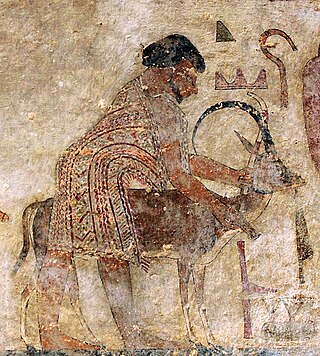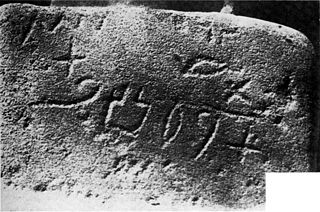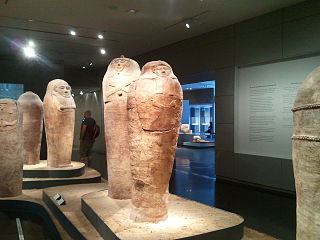
Hyksos is a term which, in modern Egyptology, designates the kings of the Fifteenth Dynasty of Egypt. The seat of power of these kings was the city of Avaris in the Nile delta, from where they ruled over Lower and Middle Egypt up to Cusae.

Avaris was the Hyksos capital of Egypt located at the modern site of Tell el-Dab'a in the northeastern region of the Nile Delta. As the main course of the Nile migrated eastward, its position at the hub of Egypt's delta emporia made it a major capital suitable for trade. It was occupied from about the 18th century BC until its capture by Ahmose I.

The Fifteenth Dynasty was a foreign dynasty of ancient Egypt. It was founded by Salitis, a Hyksos from West Asia whose people had invaded the country and conquered Lower Egypt. The 15th, 16th, and 17th Dynasties of ancient Egypt are often combined under the group title, Second Intermediate Period. The 15th Dynasty dates approximately from 1650 to 1550 BC.

Proto-Sinaitic is found in a small corpus of c.40 inscriptions and fragments, the vast majority from Serabit el-Khadim in the Sinai Peninsula, dating to the Middle Bronze Age. They are considered the earliest trace of alphabetic writing and the common ancestor of both the Ancient South Arabian script and the Phoenician alphabet, which led to many modern alphabets including the Greek alphabet. According to common theory, Canaanites or Hyksos who spoke a Semitic language repurposed Egyptian hieroglyphs to construct a different script.

Minoan pottery has been used as a tool for dating the mute Minoan civilization. Its restless sequence of quirky maturing artistic styles reveals something of Minoan patrons' pleasure in novelty while they assist archaeologists in assigning relative dates to the strata of their sites. Pots that contained oils and ointments, exported from 18th century BC Crete, have been found at sites through the Aegean islands and mainland Greece, on Cyprus, along coastal Syria and in Egypt, showing the wide trading contacts of the Minoans.
Leontopolis is the Greek name for the modern area of Tell el Yehudiye or Tell el-Yahudiya. It was an ancient city of Egypt in the 13th nome of Lower Egypt, on the Pelusiac branch of the Nile. This site is known for its distinctive pottery known as Tell el-Yahudiyeh Ware.

Semqen was a Hyksos ruler of Lower Egypt during the Second Intermediate Period in the mid-17th century BC. According to Jürgen von Beckerath he was the third king of the 16th Dynasty and a vassal of the Hyksos kings of the 15th Dynasty. This opinion was shared by William C. Hayes and Wolfgang Helck but recently rejected by Kim Ryholt. In his 1997 study of the Second Intermediate Period, Ryholt argues that the kings of the 16th Dynasty ruled an independent Theban realm c. 1650–1580 BC. Consequently, Ryholt sees Semqen as an early Hyksos king of the 15th Dynasty, perhaps its first ruler. This analysis has convinced some Egyptologists, such as Darrell Baker and Janine Bourriau, but not others including Stephen Quirke.

Maaibre Sheshi was a ruler of areas of Egypt during the Second Intermediate Period. The dynasty, chronological position, duration and extent of his reign are uncertain and subject to ongoing debate. The difficulty of identification is mirrored by problems in determining events from the end of the Middle Kingdom to the arrival of the Hyksos in Egypt. Nonetheless, Sheshi is, in terms of the number of artifacts attributed to him, the best-attested king of the period spanning the end of the Middle Kingdom and the Second Intermediate period; roughly from c. 1800 BC until 1550 BC. Hundreds of scaraboid seals bearing his name have been found throughout Canaan, Egypt, Nubia, and as far away as Carthage, where some were still in use 1,500 years after his death.

Pottery and ceramics have been produced in the Levant since prehistoric times.

Tall al-Ajjul or Tell el-'Ajul is an archaeological mound or tell in the Gaza Strip. The fortified city excavated at the site dates as far back as ca. 2000-1800 BCE and was inhabited during the Bronze Age. It is located at the mouth of Wadi Ghazzah just south of the town of Gaza.

Philistine Bichrome ware is an archaeological term coined by William F. Albright in 1924 which describes pottery production in a general region associated with the Philistine settlements during the Iron Age I period in ancient Canaan. The connection of the pottery type to the "Philistines" is still held by many scholars, although some question its methodological validity.

Kamares ware is a distinctive type of Minoan pottery produced in Crete during the Minoan period, dating to MM IA. By the LM IA period, or the end of the First Palace Period, these wares decline in distribution and "vitality". They have traditionally been interpreted as a prestige artifact, possibly used as an elite table-ware.

Tell el-Dab'a is an archaeological site in the Nile Delta region of Egypt where Avaris, the capital city of the Hyksos, once stood. Avaris was occupied by Asiatics from the end of the 12th through the 13th Dynasty. The site is known primarily for its Minoan frescoes.

Chocolate-on-White ware is the description commonly given to an important diagnostic ceramic type of Bronze Age Southern Levant. It is characterized by a white slip and dark-brown or black decorations on it. Often it is also classified as bichrome decorated pottery ware, although it also sometimes comes in monochrome variety.

Cypriot Bichrome ware is a type of Late Bronze Age, and Iron Age, pottery that is found widely on Cyprus and in the Eastern Mediterranean. This type of pottery is found in many sites on Cyprus, in the Levant, and also in Egypt. It was typically produced on a pottery wheel. A large variety of decorations and motifs are attested. This pottery is very similar to certain types of the Mycenaean pottery from various locations.

The anthropoid ceramic coffins of the Late Bronze Age Levant are a unique burial practice that is a synthesis of Egyptian and Near Eastern ideologies. The coffins date from the 14th to 10th centuries BCE and have been found at Deir el-Balah, Beth Shean, Lachish, Tell el-Far’ah, Sahab, and most recently in the Jezreel Valley in 2013. The coffins show Egyptian influence in the Ancient Near East and exhibit many Egyptian qualities in the depictions on the face masks on the lids. The lids can be separated into two artistic categories, the natural and grotesque, and the bodies are separated into type A, tapered from the shoulders, and type B, cylindrical. The graves contain wealthy funerary offerings from a variety of origins from Cyprus, Mycenae, Egypt, Phoenicia, and Canaan. The graves appear to be originally reserved for Egyptian officials and then later became a part of Canaanite and Philistine culture.

Ancient Egyptian pottery includes all objects of fired clay from ancient Egypt. First and foremost, ceramics served as household wares for the storage, preparation, transport, and consumption of food, drink, and raw materials. Such items include beer and wine mugs and water jugs, but also bread moulds, fire pits, lamps, and stands for holding round vessels, which were all commonly used in the Egyptian household. Other types of pottery served ritual purposes. Ceramics are often found as grave goods.

Tell Jemmeh, also known in Hebrew as Tel Gamma or Tel Re'im, is a prominent mound, or tell, located in the region of the northwestern Negev and the southern coastal plain of Israel, about 12 km south of Gaza, bounded by the kibbutz of Re'im 2 km to the east, and the kibbutz of Kisufim 6 km to the west, and is 9 km east of the Mediterranean coast. The site is located at the confluence of two streams, Nahal Besor and Nahal Gerar. Both have changed their course in this area many times throughout history. Re'im is a modern secular kibbutz town located to the east nearby.
Tell el-Far'ah (South) is an archaeological site on the bank of HaBesor Stream in the northern Negev region, Israel. Not to be confused with the site Tell el-Far'ah (North). It is located between the modern settlements of Ein HaBesor and Urim, some 12 kilometres (7.5 mi) from the modern city of Ofakim and 20 kilometres (12 mi) from Gaza.

Black-topped pottery is a specialized type of Ancient Egyptian pottery that was found in Nubian archaeological sites, including Elephantine, an island on the Nile River, Nabta Playa in the Nubian Desert, and Kerma in present-day Sudan. This type of artifact dates predominantly to the Predynastic Period, but “a handful of examples made in the Early Dynastic Period are known to exist.” These vessels were used “exclusively for ritual and funerary purposes” and were discovered in ancient cemeteries and settlements. The majority of these pots are variations of the Egyptian hes-jar form and feature red bodies with black tops and interiors. The red color is derived from the natural iron that occurs within Nile silts which oxidizes upon firing, and the black top and interior is a product of reduction firing and carbon smudging.




















